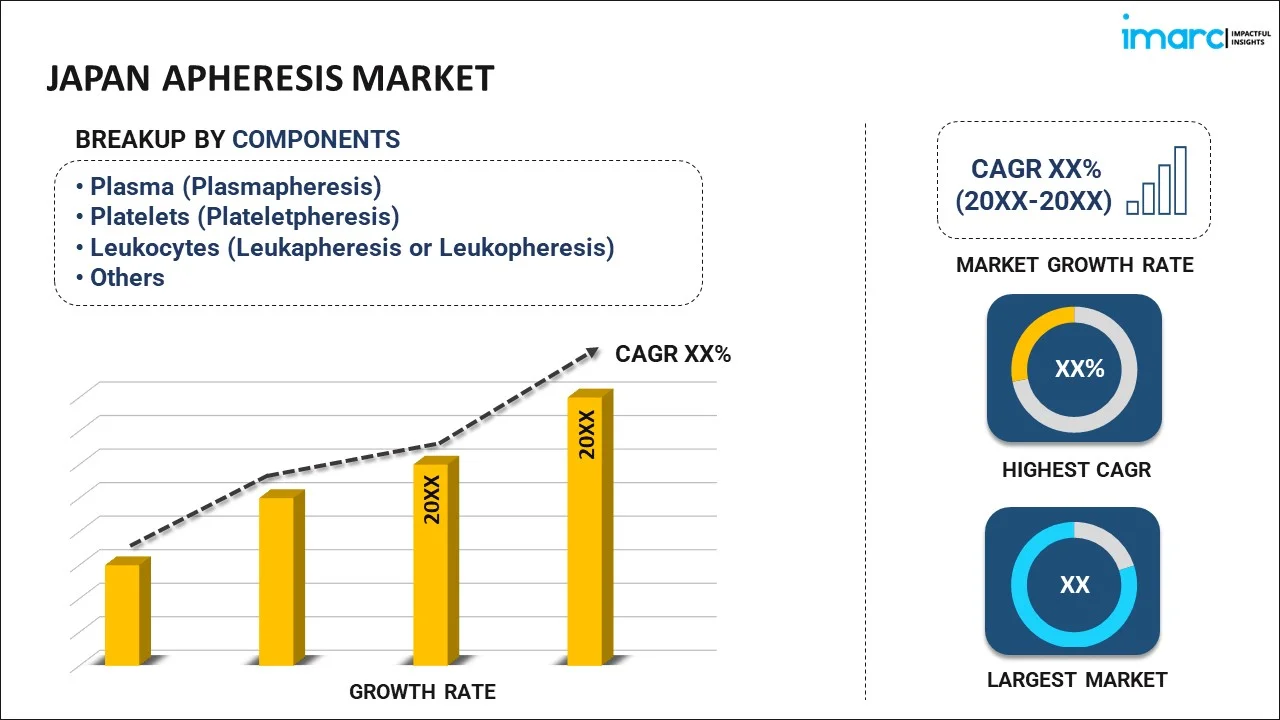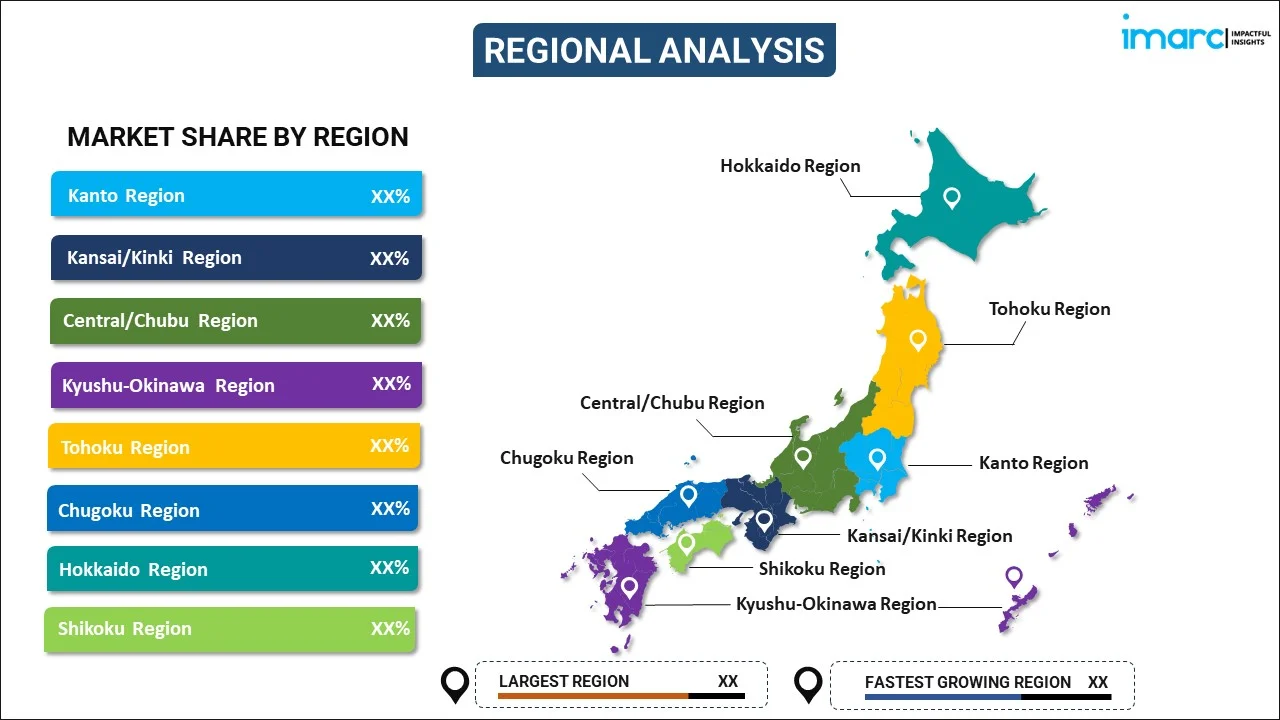
Japan Apheresis Market Report by Component (Plasma (Plasmapheresis), Platelets (Plateletpheresis), Leukocytes (Leukapheresis or Leukopheresis), Lymphocytes (Lymphopheresis or Lymphapheresis), RBC's (Erythropheresis)), Product (Devices, Disposables and Reagents, Software), Technology (Centrifugation, Membrane Separation, Selective Adsorption), Procedure (Donor/Automated Apheresis, Therapeutic Apheresis), Application (Renal Disorders, Hematological Disorders, Neurological Disorders, Autoimmune Disorders, and Others), End User (Blood Centers, Hospitals, and Others), and Region 2025-2033
Market Overview:
Japan apheresis market size reached USD 142.6 Million in 2024. Looking forward, IMARC Group expects the market to reach USD 252.9 Million by 2033, exhibiting a growth rate (CAGR) of 6.08% during 2025-2033. The increasing incidence of chronic diseases such as cancer, autoimmune disorders, and blood-related conditions, the rapid technological advancements in apheresis equipment, the rising awareness among healthcare professionals and patients about the benefits of apheresis procedures, and the heavy investments in healthcare infrastructure are some of the factors propelling the market.
|
Report Attribute
|
Key Statistics
|
|---|---|
|
Base Year
|
2024 |
|
Forecast Years
|
2025-2033
|
|
Historical Years
|
2019-2024
|
| Market Size in 2024 | USD 142.6 Million |
| Market Forecast in 2033 | USD 252.9 Million |
| Market Growth Rate (2025-2033) | 6.08% |
Apheresis, a medical procedure with therapeutic applications, involves the separation and removal of specific blood components from a donor or patient. The process utilizes a sophisticated machine known as an apheresis machine, which allows for the selective extraction and retention of blood components, such as plasma, platelets, red blood cells, or white blood cells. This separation is achieved through centrifugation or filtration, depending on the targeted blood component. One of the primary therapeutic applications of it is in the treatment of various medical conditions, including autoimmune disorders, hematologic diseases, and neurological disorders. For example, in autoimmune diseases like multiple sclerosis or myasthenia gravis, apheresis can remove harmful antibodies from the patient's blood, mitigating the impact of the disease. Similarly, in hematologic disorders like leukemia, apheresis aids in collecting specific blood components for therapeutic use or transplantation. Additionally, it plays a crucial role in blood donation processes, allowing for the collection of specific components needed for various medical treatments while returning the remaining components to the donor. This targeted blood component collection enhances the efficiency of blood donation practices, ensuring a steady and diverse supply of blood products for medical interventions. The evolving field of apheresis continues to contribute to advancements in therapeutic and donation-related medical practices, providing clinicians with a powerful tool to selectively manage blood components to benefit patients facing a spectrum of health challenges.
Japan Apheresis Market Trends:
The market in Japan is majorly driven by the expanding scope of therapeutic applications. In line with this, the rapid advancements in apheresis machine technologies contribute significantly to market growth. Continuous innovations in device design, automation, and precision in blood component separation enhance the efficiency and safety of apheresis procedures, making them more accessible and attractive to healthcare providers. These technological enhancements also lead to reduced procedure times and improved patient comfort, further driving the adoption of apheresis in clinical settings. Furthermore, the rising prevalence of chronic and autoimmune diseases fuels the demand for apheresis procedures. Conditions such as cancer, autoimmune disorders, and hematologic diseases often require targeted removal or collection of specific blood components to manage symptoms or facilitate treatments. Apheresis serves as a crucial therapeutic intervention by allowing the selective extraction of disease-related components, contributing to disease management and improving patient outcomes. As the burden of chronic diseases continues to increase, the demand for apheresis procedures as a therapeutic option is expected to grow. Besides, the widespread therapeutic applications for apheresis broaden its market potential. Beyond traditional uses, apheresis is finding applications in neurology, nephrology, and hematology, among other medical specialties. This diversification of applications positions apheresis as a versatile and valuable tool in various healthcare scenarios, contributing to its sustained market growth. Additionally, the growing awareness among healthcare professionals about the benefits of apheresis in managing a wide range of medical conditions further propels its adoption.
Japan Apheresis Market Segmentation:
IMARC Group provides an analysis of the key trends in each segment of the market, along with forecasts at the country level for 2025-2033. our report has categorized the market based on component, product, technology, procedure, application, and end user.
Component Insights:

- Plasma (Plasmapheresis)
- Platelets (Plateletpheresis)
- Leukocytes (Leukapheresis or Leukopheresis)
- Lymphocytes (Lymphopheresis or Lymphapheresis)
- RBC's (Erythropheresis)
The report has provided a detailed breakup and analysis of the market based on the component. This includes plasma (plasmapheresis), platelets (plateletpheresis), leukocytes (leukapheresis or leukopheresis), lymphocytes (lymphopheresis or lymphapheresis), and RBC's (erythropheresis).
Product Insights:
- Devices
- Disposables and Reagents
- Software
A detailed breakup and analysis of the market based on the product have also been provided in the report. This includes devices, disposables and reagents, and software.
Technology Insights:
- Centrifugation
- Membrane Separation
- Selective Adsorption
The report has provided a detailed breakup and analysis of the market based on the technology. This includes centrifugation, membrane separation, and selective adsorption.
Procedure Insights:
- Donor/Automated Apheresis
- Therapeutic Apheresis
A detailed breakup and analysis of the market based on the procedure have also been provided in the report. This includes donor/automated apheresis and therapeutic apheresis.
Application Insights:
- Renal Disorders
- Hematological Disorders
- Neurological Disorders
- Autoimmune Disorders
- Others
The report has provided a detailed breakup and analysis of the market based on application. This includes renal disorders, hematological disorders, neurological disorders, autoimmune disorders, and others.
End User Insights:
- Blood Centers
- Hospitals
- Others
A detailed breakup and analysis of the market based on the end user have also been provided in the report. This includes blood centers, hospitals, and others.
Regional Insights:

- Kanto Region
- Kansai/Kinki Region
- Central/ Chubu Region
- Kyushu-Okinawa Region
- Tohoku Region
- Chugoku Region
- Hokkaido Region
- Shikoku Region
The report has also provided a comprehensive analysis of all the major regional markets, which include Kanto Region, Kansai/Kinki Region, Central/ Chubu Region, Kyushu-Okinawa Region, Tohoku Region, Chugoku Region, Hokkaido Region, and Shikoku Region.
Competitive Landscape:
The market research report has also provided a comprehensive analysis of the competitive landscape. Competitive analysis such as market structure, key player positioning, top winning strategies, competitive dashboard, and company evaluation quadrant has been covered in the report. Also, detailed profiles of all major companies have been provided.
Japan Apheresis Market Report Coverage:
| Report Features | Details |
|---|---|
| Base Year of the Analysis | 2024 |
| Historical Period | 2019-2024 |
| Forecast Period | 2025-2033 |
| Units | Million USD |
| Scope of the Report | Exploration of Historical and Forecast Trends, Industry Catalysts and Challenges, Segment-Wise Historical and Predictive Market Assessment:
|
| Components Covered | Plasma (Plasmapheresis), Platelets (Plateletpheresis), Leukocytes (Leukapheresis or Leukopheresis), Lymphocytes (Lymphopheresis or Lymphapheresis), RBC's (Erythropheresis) |
| Products Covered | Devices, Disposables and Reagents, Software |
| Technologies Covered | Centrifugation, Membrane Separation, Selective Adsorption |
| Procedures Covered | Donor/Automated Apheresis, Therapeutic Apheresis |
| Applications Covered | Renal Disorders, Hematological Disorders, Neurological Disorders, Autoimmune Disorders, Others |
| End Users Covered | Blood Centers, Hospitals, Others |
| Regions Covered | Kanto Region, Kansai/Kinki Region, Central/ Chubu Region, Kyushu-Okinawa Region, Tohoku Region, Chugoku Region, Hokkaido Region, Shikoku Region |
| Customization Scope | 10% Free Customization |
| Post-Sale Analyst Support | 10-12 Weeks |
| Delivery Format | PDF and Excel through Email (We can also provide the editable version of the report in PPT/Word format on special request) |
Key Questions Answered in This Report:
- How has the Japan apheresis market performed so far and how will it perform in the coming years?
- What has been the impact of COVID-19 on the Japan apheresis market?
- What is the breakup of the Japan apheresis market on the basis of component?
- What is the breakup of the Japan apheresis market on the basis of product?
- What is the breakup of the Japan apheresis market on the basis of technology?
- What is the breakup of the Japan apheresis market on the basis of procedure?
- What is the breakup of the Japan apheresis market on the basis of application?
- What is the breakup of the Japan apheresis market on the basis of end user?
- What are the various stages in the value chain of the Japan apheresis market?
- What are the key driving factors and challenges in the Japan apheresis?
- What is the structure of the Japan apheresis market and who are the key players?
- What is the degree of competition in the Japan apheresis market?
Key Benefits for Stakeholders:
- IMARC’s industry report offers a comprehensive quantitative analysis of various market segments, historical and current market trends, market forecasts, and dynamics of the Japan apheresis market from 2019-2033.
- The research report provides the latest information on the market drivers, challenges, and opportunities in the Japan apheresis market.
- Porter's five forces analysis assist stakeholders in assessing the impact of new entrants, competitive rivalry, supplier power, buyer power, and the threat of substitution. It helps stakeholders to analyze the level of competition within the Japan apheresis industry and its attractiveness.
- Competitive landscape allows stakeholders to understand their competitive environment and provides an insight into the current positions of key players in the market.
Need more help?
- Speak to our experienced analysts for insights on the current market scenarios.
- Include additional segments and countries to customize the report as per your requirement.
- Gain an unparalleled competitive advantage in your domain by understanding how to utilize the report and positively impacting your operations and revenue.
- For further assistance, please connect with our analysts.
 Inquire Before Buying
Inquire Before Buying
 Speak to an Analyst
Speak to an Analyst
 Request Brochure
Request Brochure
 Request Customization
Request Customization




.webp)




.webp)












